

Wushu.com - Your Source for Wushu, wushu related items and Martial Arts. Shotokan Karate of America. Keith Jones Home Page. Martial arts associations. Martialarts.org - a guide to all styles of the martial arts. Index. Welcome to USA Karate, the NGB For the Sport of Karate in the United States. Welcome to the USMA. Yin Style Baguazhang International.
WORLD KARATE FEDERATION. Karate. Karate (空手?)
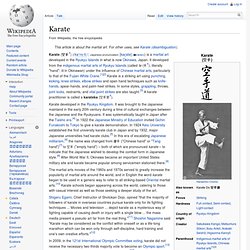
(/kəˈrɑːtiː/; Japanese pronunciation: [kaɽate] ( Karate developed in the Ryukyu Kingdom. It was brought to the Japanese mainland in the early 20th century during a time of cultural exchanges between the Japanese and the Ryukyuans. It was systematically taught in Japan after the Taisho era.[4] In 1922 the Japanese Ministry of Education invited Gichin Funakoshi to Tokyo to give a karate demonstration. In 1924 Keio University established the first university karate club in Japan and by 1932, major Japanese universities had karate clubs.[5] In this era of escalating Japanese militarism,[6] the name was changed from 唐手 ("Chinese hand" or "Tang hand")[7] to 空手 ("empty hand") – both of which are pronounced karate – to indicate that the Japanese wished to develop the combat form in Japanese style.[8] After World War II, Okinawa became an important United States military site and karate became popular among servicemen stationed there.[9] History[edit]
Dai Nippon Butoku Kai. Dai Nippon Butoku Kai (DNBK) 大日本武徳会 (lit.
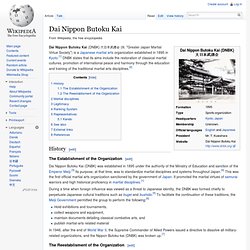
Budō. Budō (武道?)
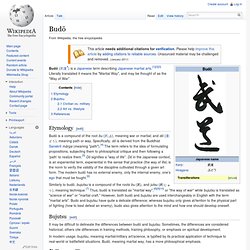
Mother of all Martial Arts – Kalarippayattu « Art of Celebrating Life! – by Gurudev © 2005-2008. Portal:Martial arts. Indian martial arts. Kalari. The word Kalari means "threshing floor" or "battlefield" in Malayalam. Training for Kalaripayattu, a martial art of Kerala is traditionally done inside the Kalari. Also the past village schools of Kerala, run by the traditional astrologers families were known by the name Kalari or Ezhuthu Kalari.[1] Every Kalari has a Puttara (meaning "platform where flowers are kept" in Malayalam). The Puttara is a seven tiered platform placed in the south-west corner and houses the guardian deity of the Kalari.
The seven tiers symbolise the seven abilities that each person must possess: Vignesva (strength), Channiga (patience), Vishnu (power to command), Vadugashcha (the posture), Tadaguru (training), Kali (the expression) and Vakasta - purushu (sound). There is also a Guruthara inside all kalaris. Kalari also meant to be the pre-school in Kerala. Which is the oldest form of martial arts known to man. Ju Jitsu.

Read its origin: Although the origin of Jujitsu is not clear, and no fixed date of its first appearance can be ascertained, there is no doubt that it is a purely Japanese art. Further, it has not been derived from ancient Chinese Martial Arts as some scholars of the martial arts have proposed. It has been a common belief of various researchers that a Chinese priest named Chin Genpin brought the art of Kempo, "kicking and striking", to Japan around 1659.
In 1659, Chin Genpin became a naturalized Japanese subject and died in 1671. While engaged in the practice of Jujitsu at the Kokushij Temple in Tokyo, he taught three ronin (out of work samurai) named Fukuno, Isogai, and Miura. Evidence that Jujitsu prevailed in Japan in ancient times is indicated by an incident, which occurred in 24 B. Kalari. History of martial arts. Although the earliest evidence of martial arts goes back millennia, the true roots are difficult to reconstruct.
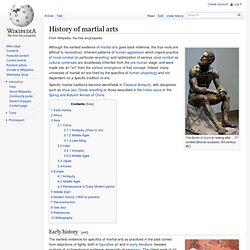
Inherent patterns of human aggression which inspire practice of mock combat (in particular wrestling) and optimization of serious close combat as cultural universals are doubtlessly inherited from the pre-human stage, and were made into an "art" from the earliest emergence of that concept. Indeed, many universals of martial art are fixed by the specifics of human physiology and not dependent on a specific tradition or era. Specific martial traditions become identifiable in Classical Antiquity, with disciplines such as shuai jiao, Greek wrestling or those described in the Indian epics or the Spring and Autumn Annals of China. Early history[edit] Minoan youths boxing, reconstruction of a Knossos fresco (1500 BC). Wrestling is a human universal, and is also observed in other great apes, especially in juveniles. Africa[edit] Martial arts.
The martial art of boxing was practiced in the ancient Thera.
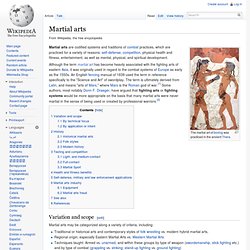
Martial arts are codified systems and traditions of combat practices, which are practiced for a variety of reasons: self-defense, competition, physical health and fitness, entertainment, as well as mental, physical, and spiritual development. Variation and scope[edit] Martial arts may be categorized along a variety of criteria, including: By technical focus[edit] Unarmed Grappling Weapon-based. Historical European martial arts. Historical European martial arts (HEMA) refers to martial arts of European origin, particularly using arts formerly practised, but having since died out or evolved into very different forms.

While there is limited surviving documentation of the martial arts of Classical Antiquity (such as Ancient Greek wrestling or Gladiatorial combat), surviving dedicated technical treatises or combat manuals date to the Late Middle Ages and the Early Modern period. For this reason, the focus of HEMA is de facto on the period of the half-millennium of ca. 1300 to 1800, with a German and an Italian school flowering in the Late Middle Ages and the Renaissance (14th to 16th centuries), followed by Spanish, French, English and Scottish schools of fencing in the modern period (17th and 18th centuries).
Japanese martial arts. Japanese martial arts are the enormous variety of martial arts native to Japan.
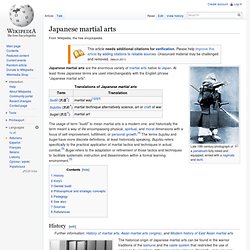
At least three Japanese terms are used interchangeably with the English phrase "Japanese martial arts": The usage of term "budō" to mean martial arts is a modern one, and historically the term meant a way of life encompassing physical, spiritual, and moral dimensions with a focus of self-improvement, fulfillment, or personal growth.[4] The terms bujutsu and bugei have more discrete definitions, at least historically speaking. Bujutsu refers specifically to the practical application of martial tactics and techniques in actual combat.[5] Bugei refers to the adaptation or refinement of those tactics and techniques to facilitate systematic instruction and dissemination within a formal learning environment.[5] History[edit] Disarming an attacker using a tachi-dori ("sword-taking") technique.
Ordinarily, the development of combative techniques is intertwined with the tools used to execute those techniques. Chinese martial arts. Kronos: 1350-1699. The National Library of Canada provides an authorized mirror of this e-publication.

The base document, however, is the one at Most recent update: December 2004. Copyright © 2000-2004 Joseph R. Svinth All rights reserved. Introduction.